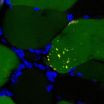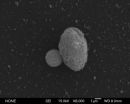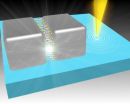(Press-News.org) In the study published today in the Journal of Clinical Investigation (JCI), one of the journals with highest impact in experimental medicine, the researchers associate the activity of the DOR protein with muscle atrophy and point to DOR as a plausible target against which to develop a drug to prevent muscle deterioration in certain diseases.
DOR (Diabetes- and Obesity-regulated gene), also known as TP53INP2, is a protein involved in autophagy, a quality control process that ensures cells stay healthy. The researchers have found that increased DOR expression in the muscle of diabetic mice leads to enhanced autophagy, which in turn favours the loss of muscle mass in these animals.
The advantage of developing a DOR inhibitor is that autophagy, a process necessary to keep cells healthy, would not be completely blocked in the absence of this protein. DOR is not essential for autophagy, but acts more as an accelerator. Thus, the inhibition of DOR would only partially reduce autophagy as other molecules involved would exert their activity normally, thus maintaining the levels of autophagy in a beneficial range for cells.
"If we could treat patients with sarcopenia and cachexia, or people at risk of these conditions, using a drug to inhibitor DOR then we would be able to stop or prevent muscle wasting," explains the expert in diabetes and obesity Zorzano, head of the "Heterogenic and Polygenic Diseases" lab at IRB.
"We are showing pharmaceutical researchers a new possible therapeutic target for two diseases that seriously impair the quality of lives of those who suffer from them," says the scientist.
An answer to why type 2 diabetic patients lose less muscle than those with type 1
The study also solves a biomedical enigma related to diabetes. Physicians did not understand why patients with type 2 diabetes—who become resistance to insulin or have very low levels of this hormone—are able to maintain muscle mass or minimize muscle wasting compared to patients with type 1 diabetes—who do not produce insulin—who show a clear loss of muscle mass. The IRB researchers demonstrate that the repression of DOR in muscle cells of type 2 diabetic animals allows the maintenance of muscle mass.
"We interpret DOR repression, which occurs naturally, as an adaptation mechanism to preserve muscle mass and to maintain greater muscular strength in type 2 diabetics," explains David Sala, first author of the study, who has recently started a post-doctoral training period at Sanford-Burnham Medical Research Institute, in La Jolla, California.
Besides working with mice, the scientists have performed experiments on biopsies from skeletal muscle of patients with diabetes and patients resistant to insulin, thanks to collaboration with clinicians from the Université Lyon 1, in France, and from the Medical University of Byalistok, Poland, also included among the authors.
INFORMATION:
The project developed in Dr. Zorzano's lab at IRB has been funded by the Centro de Investigación Biomédica en Red de Diabetes y Enfermedades Metabólicas (CIBERDEM), the Spanish Ministry of Economy and Knowledge, and the European project DIOMED, part of the Interreg-SUDOE programme.
Reference article:
Autophagy-regulating TP53INP2 mediates muscle wasting and is repressed in diabetes
David Sala, Saška Ivanova, Natàlia Plana, Vicent Ribas,Jordi Duran, Daniel Bach, Saadet Turkseven, Martine Laville, Hubert Vidal, Monika Karczewska-Kupczewska, Irina Kowalska, Marek Straczkowski, Xavier Testar, Manuel Palacín, Marco Sandri, Antonio L. Serrano, Antonio Zorzano
Journal of Clinical Investigation (2014) doi: 10.1172/JCI72327
Identified a new possible target to combat muscle wasting
IRB Barcelona scientists hypothesize that the design of an inhibitor against DOR would serve to prevent and tackle muscle wasting in patients suffering from sarcopenia and cachexia
2014-04-09
ELSE PRESS RELEASES FROM THIS DATE:
UNC researchers show how cancer cells may respond to mechanical force
2014-04-09
April 9, 2014 The push and pull of physical force can cause profound changes in the behavior of a cell. Two studies from researchers working at the UNC Lineberger Comprehensive Cancer Center reveal how cells respond to mechanical manipulation, a key factor in addressing the underlying causes of cancer and other diseases.
The studies, published in Nature Cell Biology and the Journal of Immunology, have their roots in a longtime partnership between the labs of Keith Burridge, PhD, Kenan Professor of Cell Biology and Physiology in the UNC School of Medicine, and Richard ...
Study examines mental health toll exacted on civilians working with military in war zones
2014-04-09
WASHINGTON, DC, April 9, 2014 — The punishing psychological toll endured by military personnel in war zones has been extensively documented for years by researchers, perhaps more than ever in the wake of recent military engagements in Iraq and Afghanistan.
But there has been a troubling dearth of research examining the mental health toll exacted on the large numbers of civilians who work with the military in war zones.
Sociologists Alex Bierman, an assistant professor at the University of Calgary, and Ryan Kelty, an associate professor at Washington College in Maryland, ...
Scientists in Singapore develop novel ultra-fast electrical circuits using light-generated tunneling
2014-04-09
Singapore, 9 April 2014 – Assistant Professor Christian A. Nijhuis of the Department of Chemistry at the National University of Singapore's (NUS) Faculty of Science, in collaboration with researchers from the Agency for Science, Technology and Research (A*STAR), namely Dr Bai Ping of the Institute of High Performance Computing and Dr Michel Bosman of the Institute of Materials Research and Engineering has successfully designed and fabricated electrical circuits that can operate at hundreds of terahertz frequencies, which is tens of thousands times faster than today's state-of-the-art ...
Physical function and sense of autonomy determine life-space mobility in older people
2014-04-09
Physical function and sense of autonomy are independent determinants of life-space mobility in older people. This was found in a study conducted at the Gerontology Research Center of the University of Jyväskylä. In this project, 848 older men and women that lived independently in the Jyväskylä region in Central Finland were interviewed at their own home.
Life-space mobility reflects a person's mobility with or without the use of a vehicle. Life-space mobility reflects an individual's opportunities to participate in the society. An individual's life-space may be restricted ...
Technical tests of biodiversity
2014-04-09
What happens when physicists play (using mathematical instruments) with the genetics of populations? They may discover unexpected connections between migration and biodiversity, for example, as recently done by a group of researchers from the International School for Advanced Studies (SISSA) in Trieste and the Polytechnic University in Turin in a study published in the journal Physical Review Letters.
The effect of migration on biodiversity (intended as the coexistence of different genetic traits) is an open question: does migration increase or decrease the genetic variability ...
Brain size influences development of individual cranial bones
2014-04-09
VIDEO:
This shows skull and skeletal development of a 25-year-old musk shrew embryo.
Click here for more information.
Embryonic development in animals – except mice and rats – remains largely unexplored. For a research project at the University of Zurich, the embryos of 134 species of animal were studied non-invasively for the first time using microcomputer imaging, thus yielding globally unique data. The embryos studied came from museum collections all over the world. The international ...
USA top in the world for entrepreneurship
2014-04-09
The USA is the most entrepreneurial economy in the world, according to the 2014 Global Entrepreneurship and Development Index (GEDI). (See Notes to Editors for the complete rankings.)
The GEDI index combines data on entrepreneurial activities and aspirations with data describing how well the country supports entrepreneurial activity in the US and 119 other countries across the world.
The USA came top, followed by Australia and Sweden in second and third place, respectively.
The researchers found that the USA is a world leader when it comes to financing new businesses ...
Researchers say Neanderthals were no strangers to good parenting
2014-04-09
Archaeologists at the University of York are challenging the traditional view that Neanderthal childhood was difficult, short and dangerous.
A research team from PALAEO (Centre for Human Palaeoecology and Evolutionary Origins) and the Department of Archaeology at York offer a new and distinctive perspective which suggests that Neanderthal children experienced strong emotional attachments with their immediate social group, used play to develop skills and played a significant role in their society.
The traditional perception of the toughness of Neanderthal childhood is ...
Polysaccharides from Angelica sinensis alleviate oxidative damage to neurons
2014-04-09
According to traditional Chinese medicine, the roles of Angelica sinensis correlate with tonifying the blood and promoting its circulation. Recent studies have shown that extracts of Angelica sinensis have antioxidative and neuroprotective effects. However, the anti-oxidative function of Angelica sinensis polysaccharide has rarely been addressed. In a preliminary experiment from Dr. Tao Lei and colleagues from Zhongnan Hospital of Wuhan University in China, Angelica sinensis polysaccharides not only protected PC12 neuronal cells from H2O2-induced cytotoxicity, but also ...
Stressful environments genetically affect African American boys
2014-04-09
PRINCETON, N.J.—Stressful upbringings can leave imprints on the genes of children as young as age 9, according to a study led by Princeton University and Pennsylvania State University researchers. Such chronic stress during youth leads to physiological weathering similar to aging.
A study of 40 9-year-old black boys, published in the Proceedings of the National Academy of Sciences, shows that those who grow up in disadvantaged environments have shorter telomeres — DNA sequences that generally shrink with age — than their advantaged peers. The researchers also report ...
LAST 30 PRESS RELEASES:
Superradiant spins show teamwork at the quantum scale
Cleveland Clinic Research links tumor bacteria to immunotherapy resistance in head and neck cancer
First Editorial of 2026: Resisting AI slop
Joint ground- and space-based observations reveal Saturn-mass rogue planet
Inheritable genetic variant offers protection against blood cancer risk and progression
Pigs settled Pacific islands alongside early human voyagers
A Coral reef’s daily pulse reshapes microbes in surrounding waters
EAST Tokamak experiments exceed plasma density limit, offering new approach to fusion ignition
Groundbreaking discovery reveals Africa’s oldest cremation pyre and complex ritual practices
First breathing ‘lung-on-chip’ developed using genetically identical cells
How people moved pigs across the Pacific
Interaction of climate change and human activity and its impact on plant diversity in Qinghai-Tibet plateau
From addressing uncertainty to national strategy: an interpretation of Professor Lim Siong Guan’s views
Clinical trials on AI language model use in digestive healthcare
Scientists improve robotic visual–inertial trajectory localization accuracy using cross-modal interaction and selection techniques
Correlation between cancer cachexia and immune-related adverse events in HCC
Human adipose tissue: a new source for functional organoids
Metro lines double as freight highways during off-peak hours, Beijing study shows
Biomedical functions and applications of nanomaterials in tumor diagnosis and treatment: perspectives from ophthalmic oncology
3D imaging unveils how passivation improves perovskite solar cell performance
Enriching framework Al sites in 8-membered rings of Cu-SSZ-39 zeolite to enhance low-temperature ammonia selective catalytic reduction performance
AI-powered RNA drug development: a new frontier in therapeutics
Decoupling the HOR enhancement on PtRu: Dynamically matching interfacial water to reaction coordinates
Sulfur isn’t poisonous when it synergistically acts with phosphine in olefins hydroformylation
URI researchers uncover molecular mechanisms behind speciation in corals
Chitin based carbon aerogel offers a cleaner way to store thermal energy
Tracing hidden sources of nitrate pollution in rapidly changing rural urban landscapes
Viruses on plastic pollution may quietly accelerate the spread of antibiotic resistance
Three UH Rainbow Babies & Children’s faculty elected to prestigious American Pediatric Society
Tunnel resilience models unveiled to aid post-earthquake recovery
[Press-News.org] Identified a new possible target to combat muscle wastingIRB Barcelona scientists hypothesize that the design of an inhibitor against DOR would serve to prevent and tackle muscle wasting in patients suffering from sarcopenia and cachexia







